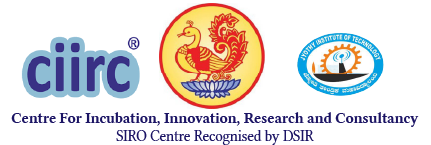Overview
Rapid changes in lifestyle havemade people to depend on processed foods, either partly or completely. In recent times, with agriculture productivity being affected due to climatic changes and rapid economic growth and population, demand for quality food has greatly increased. Most agriculture produce is not utilised completely due to spoilage, as the whole produce is not converted or processed into products with extended shelf-life or value added products. This has negative impact on food affordability, availability and safety. Therefore, new methods need to be devised to preserve food and utilize available processing methods more efficiently. In this context,one needs to realise that there is huge shortage of skilled food technology personnel and processing facilities; these issues need to be addressed for efficient utilization of agriculture produce. In addition to food processing and preservation, one need to realize the importance of food quality and safety in order to assure nutrient security and safety to consumers. From field to fork, food safety helps in the prevention of food-borne illnesses or food hazard risks by ensuring the microbial, chemical and physical quality of all food varieties. Agencies such as FSSAI (India), FDA (USA), and EFSA (Europe), are playing an important role to ensure food safety and promote fair trade and practises globally.
At the food technology lab, researchers are developing innovative food processing methods and new food products, which have the potential to solve today’s global food-related problems, including food shortages and spoilage, malnutrition, low shelf life of food products, quality control, etc. Available labs and facilities are not only utilized for research and product development, but are also used for specific training and in-hand demonstrations. Several food products with high market potential at affordable prices are being developed by the team.

Fortification of Energy Drinks for Value-addition
The food technology team is working on the fortification of millet, wheat and soy-based drinks to enhance their nutritional, functional and sensory qualities. The team is also working on the fortification of cereal energy drinks with immuno boosters.

Commercially available fortified energy drinks
Sensory Evaluation of Formulated Drinks and Processed Foods
Formulations to improve the sensory attributes of kokum drinks and their sensory evaluation is being addressed using fuzzy logic and a new method developed based on simple mathematical calculations. Both the approaches lead to similar results. However, the new approach has been found to be more user-friendly. The kokum formulation evaluated by this method has been marketed by the start-up ‘Petrichor’. It is proposed to extend this method to other processed foods.

Improving the Thermostability of Maltogenic Alpha Amylase of Aspergillus Niger by using Negative Pressure
Maltogenic alpha amylase is helpful in the production of maltose from starch. But, this enzyme is stable only up to 40°C limiting its usage in processing starch. Calcium can stabilize the enzyme up to 50°C which can be further be improved up to 70°C by using negative pressure.

Improving the Activities ofFood-related Metabolites Produced byAspergillus Carbonarius by using Nano Approaches
Pectinase has been used for fruit juice clearance and oil extraction. Partially saturated canthaxanthin, used as food colour, showed anticancer and antioxidant activities. When both metabolites were treated with carbon nanotubes (CNTs), they demonstrated significantly high activity.
Infrared-assisted Vacuum Impregnation System for Fortification of Food Products
Infrared-assisted vacuum impregnation system has been developed for fortification of vegetable products with micronutrients. The project aims to fortify micronutrients in fruits and vegetables to develop micronutrient fortified food products.
 Vacuum Impregnation System
Vacuum Impregnation System
Extraction of Nutrients from under-utilized Legumes and other unutilized Sources for Food Product Development
There are several under-utilized legumes and other types of unutilized sources of food that are good sources of protein and various nutraceuticals. Current work uses under-utilized, low-cost legumes for protein extraction and preparationof protein-rich foods for infants and adults. The objective of the work is to develop affordable, value-added food products for all.

Application of “Foldscope” as a Research Tool
Foldscope is an ultra-affordable paper microscope. It has a micro-lens with the capability of 140x magnification and 1.9μm resolution.It is used to view and video-record microscopic data with a smart phone. It can prove to be an incredible scientific tool for unprivileged people around the world. Procedures have been developedto use it to estimatethe quality of food and agriculture commodities.

Foldscope
Recovery of High Value Products from the Low Value By-products
Low value by-products (peel, pulp, kernels, seeds), generated during fruit and vegetable processing, contain high-value components like polyphenols, aromatic oils, proteins, dietary fibres, polysaccharides, etc. Current work with tamarind seeds seeks to recover polysaccharides and utilize them to make biodegradable films.
 Extending Shelf Life of Indian Dairy Products
Extending Shelf Life of Indian Dairy Products
Indian dairy products like curd, paneer, lassi, etc., are known for their good taste as well as their health-promoting properties. However, their shelf lifves are low and need to be maintained at cold temperature for extended usage. Study is ongoing on how to extend their shelf life without adding harsh preservatives.
Immobilized Enzymes for Food Processing Applications
Enzymes play an important role in food processing industries. Using immobilized enzymes is more advantageous for industries due to their stability and robustness. Researchers at the lab are using novel cross-linked enzyme aggregates to address food processing problems.
Cross-linked Enzyme Aggregates for Valorization of Agri-Food Waste: An Approach for Reaching Zero Waste
Agri-Food waste can be converted into valuable products more efficiently by utilizing novel cross linked enzyme aggregates. The team is working towards zero waste technologies by adopting this approach.
Utilization of Enzyme Inhibitors for Food Processing Applications
Sometimes, enzymes will spoil the food due to their excess activities. In that context, inhibitors can be utilized to extend the shelf-life of food. The team is also working in this direction.
Biosensors and Electronic Nose for Food Industry
Biosensors are more specific and sensitive in nature. Researchers at the lab are working on the development of biosensors for food adulterants like ammonia, urea and food flavours. It is sought to utilize the biosensors for the development of an electronic nose.
Artificial Intelligence for Food Industry
There is a need to adopt artificial intelligence for evaluating the quality of food materials which should able to reduce the time of evaluation and errors. It will also provide high throughput. Efforts have been initiated to adopt artificial intelligence for evaluating grain quality.
3D Printing for Food Processing Applications
Efforts are also on to adopt 3D printing technology for making food products.
- Bayineni VK, Kadeppagari RK. 2021. Evaluation of p-Nitrophenyl butyrate based bioautographic method for the identification of lipase inhibitors from the unexplored plant sources. Journalof Plant Biochemistry and Biotechnology. https://doi.org/10.1007/s13562-021-00686-w.IF: 1.238
- Banerjee, S. and Shrivastava, S.L. (2019). Design, development and testing of environmentally friendly rapid cashew kernel conditioning machine, Journal of Food Process Engineering, 42(4): e13055, DOI: 10.1111/jfpe.13055. IF: 1.99
- Dave UC, Kadeppagari 2019. Alanine dehydrogenase and its applications. Critical reviews in Biotechnology. 39: 648-664. IF: 5.2
- Banerjee, S. and Shrivastava, S.L. (2017). Design and development of mini-roaster for cashew nut processing, Journal of Food Process Engineering, 41 (1): DOI:10.1111/jfpe.12604
- Suresh S, Bayineni VK, Kadeppagari RK. 2017. Glycerol improves the productivity of the lipase inhibitory activity of Streptomyces coelicolor.International Journal of Pharmacy and Bio Sciences. 8(2): (B) 726-730(Scopus indexed, SNIP value 0.538)
- Singh G, Bayineni VK, Kadeppagari, RK. 2017. Characterization and kinetics of the lipase inhibitory activity of Streptomyces tendae. International Journal of Pharmacy and Bio Sciences. 8(2): (B) 270-274 (Scopus indexed, SNIP value 0.538)
- Sahu CK, Kadeppagari 2017. Sensory evaluation of kokum drinks by fuzzy logic and a simple method. International Journal of Food Properties. 20: 2608-2615. IF: 1.42
- Dave UC, Ingale DV, Venkatesh K, Bayineni VK, Kadeppagari RK. 2017. Multiwalled carbonnanotubes enhance the response and sensitivity of the ammonium biosensor based on alanine dehydrogenase. Journal of Electroanalytical Chemistry, 784:102-108. IF:3.02
• Muralidhara, H. B., & Banerjee, S. (Eds.). (2021). 3D Printing Technology and Its Diverse Applications. CRC Press
• Biotechnology for Zero Waste (ISBN 978-3-527-34898-5). 2020. Editors-Hussain CM, Kadeppagari RK, Wiley-VCH
Select Book Chapters
- Balan A, Kadeppagari RK. Biopolymers for nano-enabled packaging of food. 2020. Handbook of Polymer and Ceramic Nanotechnology, Edited by Hussain Chaudhery Mustansar and Thomas Sabu, Springer, ISBN 978-3-030-40512-0. In press.
- Banerjee S, Chandra Prakash P and Kadeppagari RK. Zein based nano-products in nutrition and food sectors. 2020. Handbook of Consumer Nano Products, Edited by Shadpour Mallakpour and Chaudhery Mustansar Hussain, Springer,In press. https://doi.org/10.1007/978-981-15-6453-6_51-1
- Rakshith KS, Kadeppagari RK. Functionalized carbon nanotubes for ammonia sensors. 2020. Environmental Applications of Carbon Nano-materials Based Devices. Edited by Shadpour Mallakpour and Chaudhery Mustansar Hussain, Wiley-VCH,In press.
- Kumar Sahu C., Dhanashri Sanjay S., Kadeppagari RK. (2021) Application of Nanotechnology for Encapsulation of Micronutrients. In: Handbook of Consumer Nanoproducts. Springer, Singapore. https://doi.org/10.1007/978-981-15-6453-6_93-1
- Banerjee, S., Haldar, S., Kumar, B. N. S., Mitra, J. (2019). Storage of fruits and vegetables – an Overview, Book Title: Packaging and Storage of Fruits and Vegetables, Apple Academic Press (AAP), CRC Publication, Wareton, NJ (USA)
Food Research Lab
Food Processing Lab
Food Analysis and Quality Control Lab
Some of the important instruments are listed below:
| UV-Vis Spec |
| Fermenter |
| Freeze dryer |
| Ultra-Freezer (-80 °C) |
| Vacuum oven |
| Micro weighing balance |
| Tip Sonicator |
| Rotary evaporator |
| Cooling centrifuge |
| Electrophoresis apparatus |
| Infrared packaging machine |
| Induction head sealer |
| Grain miller |
- Estimation of food quality based on microbial load and microstructure keeping in mind consumer’s health and food safety – using Foldscope. DBT, GoI.
- Utilization of horse gram (Macrotyloma uniflorum) for new health product development. VGST, GoK.
- Design and development of biodegradable films from food waste for food packaging. VGST, GoK.
- Improvement of thermostability and functionality of cancer therapy related enzyme isolated from Variovorax paradoxus by using nano approaches. VGST, GoK.

Ravi Kumar Kadeppagari
Ravi Kumar Kadeppagari obtained his education from premier institutes of India, such as Regional Institute of Education (constituent of NCERT), Pondicherry Central University and Central Food Technological Research Institute (constituent of CSIR). He has overseas postdoctoral experience at Northwestern University, Chicago, and LSU Health Sciences Center, New Orleans, USA. He was a recipient of the Young Scientist Research Grant from DST- SERB, New Delhi, and has completed projects from DRDO, DST, VGST and MOFPI. He played a major role in setting up a Food Technology Division at Jain University by obtaining an infrastructural grant from Ministry of Food Processing Industries, New Delhi. He was the Editorial Board Member of American Journal of Bioscience & Bioengineering andthe Associate Editor of Journal of Analytical & Pharmaceutical Research. He is an active reviewer for SCI/SCOPUS indexed international journals such as Starch, Current Microbiology, International Journal of Food Science & Technology, Journal of Separation Science, Journal of Chromatography-B, International Journal of Pharmacy & Pharmaceutical Sciences, Phytochemical Analysis, Journal of Electroanalytical Chemistry, FEMS Microbiology Letters, etc. He is a biotechnology consultant at international consulting agencies such as ‘Zintro’ and ‘Acabiz’. He is also a mentor for start-ups.
He has research publications in Scopus and SCI indexed international journals and patents to his credit. He has also supervised doctoral and master students, and is a life member of the Society of Biological Chemists, Association of Microbiologists of India, Indian Science Congress Association, Luminescence Society of India, Institute of Smart Structures & Systems, Association of Food Scientists & Technologists (India), and Society for Biotechnologists (India). He served as the Chairman of Board of Examiners, Food Technology, Jain University. He received the achievement award for his research contributions from Jain University Trust. He has also received junior and senior research fellowships from CSIR, New Delhi. He currently works as Professor at the Centre. His current research focuses on applications of enzymes, enzyme inhibitors, nanomaterials and biosensors in the food, health, biotech and environmental areas.
Email Id: ravikumar.k@ciirc.jyothyit.ac.in

Soumitra Banerjee
Soumitra Banerjee obtained his master’s and doctoral degrees from IIT, Kharagpur (India). He is the recipient of a research fellowship from Indian Council of Agricultural Research (ICAR), New Delhi. He has aboutsix years of teaching experience and has guided M. Tech. and B. Tech. students for their research projects.He has filed a few patents and published a number of papers in national and international journals. He is a life member of Association of Food Scientists & Technologists (India) and an active reviewer forthe Journal of Food Science and Technology (Springer). He currently works as Associate Professor at the Centre. His research focuses on preservation of Indian food products, micronutrient fortification, plant-based protein extraction and development of value-added food products.
Email Id: soumitra.banerjee@ciirc.jyothyit.ac.in

Chandan Kumar Sahu
Chandan Kumar Sahu obtained his education from Dr. Balasaheb Sawant Konkan Krishi Vidyapeeth, Dapoli, and IIT, Kharagpur. He qualified GATE and NET (Agricultural Scientists Recruitment Board, Dept. of Agricultural Research and Education, GoI) exams. He is a recipient of national talent scholarship from Indian Council of Agricultural Research, New Delhi. He has six years’ experience, and has publications and patents to his credit. He is currently an Assistant Professor at the Centre. His research focus on simple sensory evaluation models, technologies for improving shelf life of fruits and formulation of energy drinks. He also runs a start-up.
Email Id: chandan.kumar@ciirc.jyothyit.ac.in

Swarrna Haldar
Swarrna Haldar obtained her doctoral degree from IIT, Kharagpur. She is a recipient of research fellowships from Department of Biotechnology (DBT), New Delhi, and has worked as Product Manager/NIR Application specialist at Soquence Innovation Pvt. Ltd., a sister company of Zeutec Optoelektronik GmbH (Germany).She is currently an Assistant Professor at theCentre and her research focuses on the utilization of industrial food waste and underutilized seeds for the recovery of valuable products. She is a Life Member of the Association of Food Scientists and Technologists (India).
Email Id: swarrnahalda@ciirc.jyothyit.ac.in
